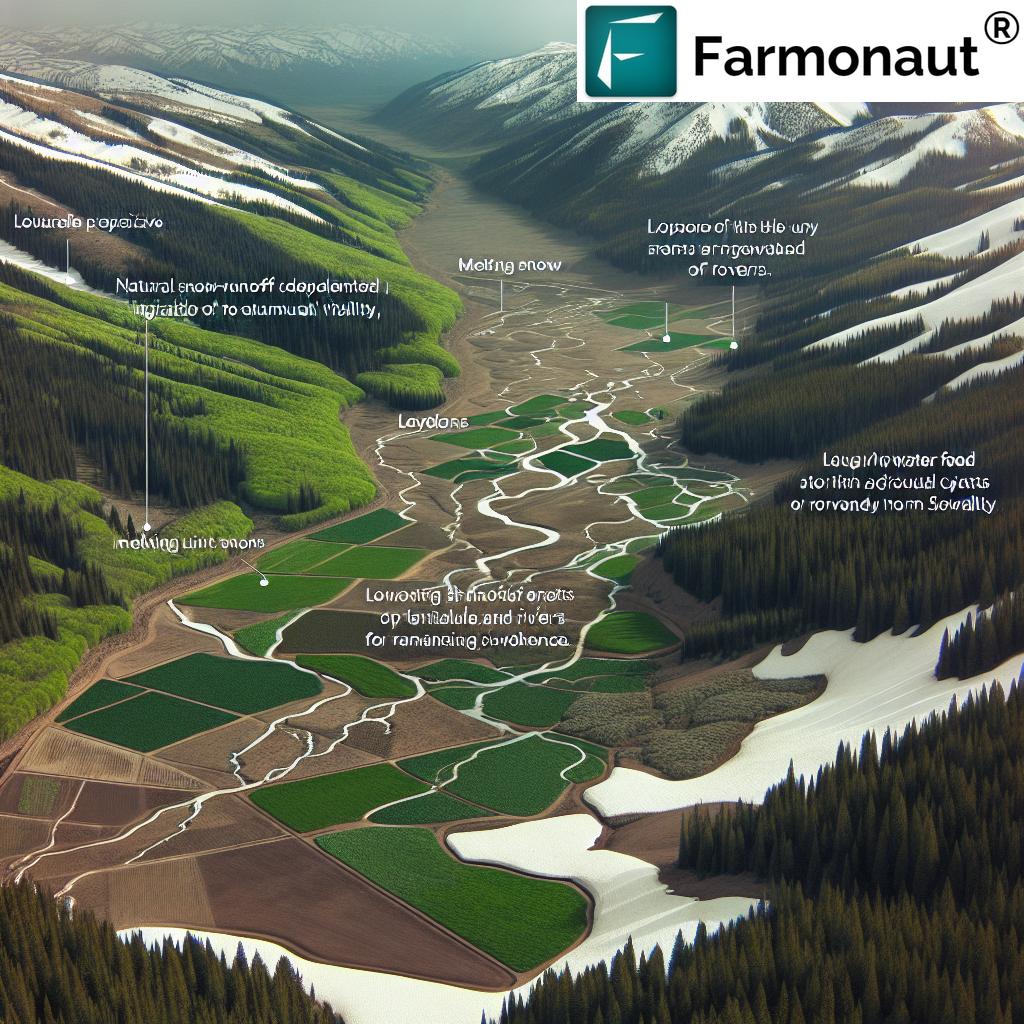Table of Contents
- USDA Farming Grant Uncertainty: 2025 Overview
- Understanding USDA Farming Grants and Their Essential Role in Agriculture
- Trivia: Key USDA Grant Uncertainty Facts for 2025
- Causes of USDA Farming Grant Uncertainty in 2025
- Comparative Risk-Solution Table: 2025 USDA Grants
- Broader Agricultural Risks and Uncertainties in 2025
- Strategies to Manage USDA Grant Uncertainty
- Role of Technology in Managing Risk and Uncertainty in Agriculture
- Evolving Landscape of USDA Agriculture Grants in 2025
- Farmonaut: Precision Agriculture Solutions for Resilience in 2025
- FAQs: Frequently Asked Questions
- Conclusion: Navigating USDA Farming Grant Uncertainty in 2025
USDA Farming Grant Uncertainty: 7 Key Risks & Solutions for 2025
“In 2025, over 30% of USDA farming grants face uncertainty due to evolving policy and environmental risks.”
“Seven major risk factors could impact USDA grant allocations, affecting thousands of U.S. farmers next year.”
USDA Farming Grant Uncertainty: 2025 Overview
The uncertainty in agriculture has always been an inseparable part of farming, forestry, and related rural industries. In 2025, the USDA farming grant uncertainty has reached new heights due to complex policy changes, climate variability, funding fluctuations, and shifting consumer and technological trends. For U.S. farmers, forestry managers, and agricultural stakeholders, understanding these uncertainties and preparing for their impact on grant eligibility and farm planning is critical for resilience.
In this in-depth analysis, we decode seven key risks shaping the 2025 USDA agriculture grants landscape, provide practical solutions, and empower producers to make informed, data-driven decisions in an evolving regulatory and environmental context. We’ll explore risk mitigation tools, digital resources, and technology strategies—while uniquely localizing the context to the United States and embedding actionable management insights for the year ahead.
Understanding USDA Farming Grants and Their Essential Role in Agriculture
The United States Department of Agriculture (USDA) administers a variety of grants, loans, and incentive programs that are fundamental for agricultural development, sustainability, and innovation in the United States.
- Purpose: Promote environmental stewardship, technological innovation, and sustainable practices.
- Popular Programs: Environmental Quality Incentives Program (EQIP), Conservation Stewardship Program (CSP), Specialty Crop Block Grant Program, and grants targeting beginning and socially disadvantaged groups.
- Impact: Grants help farmers afford new equipment, adopt precision technologies, invest in conservation, improve water management, and support rural communities.
Nevertheless, usda farming grant uncertainty can complicate farm planning, affect eligibility for funding, and reduce confidence in long-term investment—particularly for small and mid-sized operations that rely heavily on USDA support.
Trivia: Key USDA Grant Uncertainty Facts for 2025
- “In 2025, over 30% of USDA farming grants face uncertainty due to evolving policy and environmental risks.”
- “Seven major risk factors could impact USDA grant allocations, affecting thousands of U.S. farmers next year.”
Causes of USDA Farming Grant Uncertainty in 2025
Let’s delve into the specific causes of usda farming grant uncertainty in 2025 and understand how each impacts agricultural eligibility, funding dynamics, and sector-wide planning.
-
Policy and Funding Fluctuations
Federal budgets shape the volume and type of USDA agriculture grants available annually. Changing political climates, new government priorities, or emergencies (such as disasters) can quickly shift appropriations, affecting grant amounts, application cycles, and program focus.
- Uncertain funding levels for established programs (e.g., EQIP, CSP).
- Changes to eligibility or compliance requirements.
- Potential reduction or expansion of targeting for specialty crop, conservation, or socially disadvantaged groups grants.
-
Application Complexity and Competition
USDA grants in 2025 are increasingly complex, with multifaceted processes—from need for detailed data to advanced proposals covering environmental and social practices.
- High competition, especially for niche crops and innovation-focused grants.
- Resource-constrained producers may struggle with application preparation, leading to missed opportunities and perpetuating gaps in funding reach.
- Compliance burdens grow with introduction of advanced data or environmental benchmarks.
-
Climate Change and Environmental Variability
Unpredictable weather and climate variability add both urgency and complexity. Grants encouraging conservation and resilience may either rise in necessity or become mismatched if conditions rapidly evolve.
- Shifting growing seasons influence program relevance and eligibility.
- Extreme events (droughts, floods) affect water and soil management goals associated with USDA grants.
- Increased risk of grant funds being redirected to disaster response over proactive innovation.
-
Technological Disruption and Innovation Gaps
Rapid advances in precision agriculture, digital tools, and carbon management mean existing USDA programs may lag in support for the latest technologies.
- Delays in updating eligibility criteria for new practices or innovations may result in funding gaps.
- Uncertainty about investment returns when funded solutions quickly become outdated.
- Challenge for farmers in keeping up with updates and changing compliance expectations.
-
Market Fluctuations & Price Risks
Global and domestic market dynamics can influence crop prices, affecting both revenue and the ability to co-finance projects in partnership with USDA grants.
- When prices drop, farmers may not be able to fulfill cost-sharing or matching requirements.
- Price volatility impacts financial planning and the risk-reward calculus for investment in new crops or infrastructure.
-
Regulatory and Compliance Uncertainties
Ongoing regulatory changes around pesticides, water rights, carbon reporting, and land use can disrupt program eligibility or add unforeseen costs.
- New regulations may shift grant priorities or require retroactive compliance upgrades.
- Administrative burden influences both large- and small-scale farmers.
-
Social and Demographic Shifts
Aging farmer populations, rural depopulation, and changes in land ownership challenge long-term support and the ability of the sector to adapt to emerging demands.
- Potential for fewer beginning farmers or socially disadvantaged groups to take up or benefit from USDA grants.
- Changing consumer demands (organic, traceable, regenerative) create moving targets for grant-eligible projects.
Comparative Risk-Solution Table: 2025 USDA Grants
| Risk | Estimated Likelihood (2025) | Estimated Impact on Farmers | Suggested Solution/Strategy |
|---|---|---|---|
| Policy & Funding Fluctuations | High | High – Reduced grant access, uncertainty in planning | Scenario planning, policy monitoring, diversifying income streams |
| Application Complexity & Competition | Medium-High | Medium – Missed opportunities, increased burden | Capacity building, technical training, cooperative applications |
| Climate Change & Environmental Variability | High | High – Unpredictable production, shifting eligibility | Climate-smart practices, crop diversification, risk insurance |
| Technological Disruption & Innovation Gaps | Medium | Medium – Lost efficiency, outdated investments | Regular tech updates, partnerships with agtech providers |
| Market Fluctuations & Price Risks | Medium | High – Impacts financial stability, cost-sharing ability | Forward contracting, diversified markets, real-time analytics |
| Regulatory & Compliance Uncertainty | Medium-High | Medium – Added admin cost, shifting grant eligibility | Regular training, compliance management tools, advocacy |
| Social & Demographic Shifts | Medium | Medium – Fewer new farmers, limited adaptation | Succession planning, mentorship, community outreach |
Broader Agricultural Risks and Uncertainties in 2025
USDA farming grant uncertainty is deeply connected to broader risks in agriculture, from weather and market fluctuations to regulatory changes and shifting social trends. In the 2025 agricultural landscape, these uncertainties are heightened by several interrelated factors:
- Market Risks: Global events, trade policies, and changing consumer preferences influence price and production trends, impacting farmers’ financial stability.
- Production Risks: Pests, diseases, and soil degradation can disrupt yields and amplify uncertainty in year-to-year output.
- Regulatory Environment: Land use regulations, environmental compliance, and potential new carbon rules shape the choices farmers must make for eligibility and compliance with USDA programs.
- Technological Shifts: Adoption of precision agriculture, digital tools, and AI-based management affects grant application strategies and resource allocation.
- Social Dynamics: Rural depopulation, aging populations, and fewer succession planning mechanisms threaten long-term sustainability and adaptation to new grant models.
Strategies to Manage USDA Grant Uncertainty
Practical Approaches for Navigating USDA Grant Risks in 2025
- Diversification: Broadening crop, livestock, or forestry mixes can align operations with more USDA grant streams while reducing exposure to single-sector risks.
- Knowledge Building and Capacity: Staying updated with program updates from the USDA and taking advantage of extension services or local training sessions improves application strength and compliance.
-
Innovation and Digital Adoption: Leveraging data analytics, satellite monitoring, and AI-driven platforms like Farmonaut ensures precision farming practices that align with modern grant criteria.
For resource management & real-time monitoring, explore Large Scale Farm Management Tools by Farmonaut for holistic, data-driven farm operation oversight. -
Financial Planning and Risk Management: Maintaining reserve funds, securing crop insurance, and utilizing forward contracts hedge against market or production uncertainties.
For improved loan access and insurance applications, learn more about Crop Loan & Insurance Verification via Satellite. - Collective Action: Join cooperatives or advocacy groups for shared resources, group grant applications, and improved policy advocacy in times of government policy changes.
-
Sustainability-Driven Strategies: Focus on carbon management, water conservation and traceability—now key eligibility markers in modern USDA programs.
Assess how Farmonaut Carbon Footprinting helps with compliance and environmental reporting. -
Transparency and Traceability: Using transparency tools aids grant applications and builds market trust.
See Farmonaut Blockchain-Based Traceability for next-generation supply chain assurance. -
Resource Optimization: Adopting cutting-edge fleet management systems ensures inputs and assets are used efficiently—critical for competitive USDA funding.
Discover Farmonaut Fleet Management Systems for efficient, trackable field operations.
For automation and integration with your farm management systems, access the
Farmonaut Satellite & Weather Data API or consult the API Developer Docs.
Role of Technology in Managing Risk and Uncertainty in Agriculture
Risk & Uncertainty in Agriculture PPT Tools and the Future of Data-Driven Farming
In the midst of usda farming grant uncertainty, technology offers the agility needed to adapt to evolving risks and uncertainties. Tools commonly found in risk and uncertainty in agriculture ppt presentations and specialized agri-apps empower farmers to understand production, market, policy, and climate changes.
- Scenario analysis tools for grant planning under various policy or market shifts.
- AI-based advisory systems providing timely recommendations and real-time farm monitoring.
- Satellite imagery for vegetation health, soil moisture, and resource allocation.
- Blockchain for transparent and auditable record-keeping—key drivers for many 2025 USDA agriculture grants.
Did you know? Many new USDA grant programs will require digital reporting and proof of sustainable practices.
Farmonaut’s Carbon Footprinting tool
enables environmentally conscious reporting for USDA compliance and improved market access.
Evolving Landscape of USDA Agriculture Grants in 2025
Key Trends Shaping 2025 and Beyond
-
Increased Climate Resilience Funding:
There is heightened focus on climate-smart agriculture, carbon sequestration, soil quality improvement, and water conservation initiatives. -
Equity and Access:
More programs are targeting beginning farmers and socially disadvantaged groups to bridge capital and knowledge gaps. -
Digital Agriculture Enablement:
USDA farming grants increasingly support adoption of digital management tools and real-time farm monitoring. -
Resource Efficiency:
Conservation programs emphasize dual goals—optimizing production and promoting ecosystem services. -
Traceability Requirements:
Market and regulatory forces drive new demand for transparent, blockchain-powered traceability alongside compliance-focused grant programs.
Farmonaut: Precision Agriculture Solutions for Resilience in 2025
Navigating usda farming grant uncertainty requires not just awareness, but also access to practical technology and tools. At Farmonaut, our mission is to make precision agriculture tools affordable and accessible for every farmer, cooperative, and agribusiness—especially as usda, environmental, and market risks evolve in 2025.
Our Technologies for Modern Agriculture
- Satellite-Based Crop Health Monitoring: We empower farmers across more than 40 countries with real-time, actionable insights into crop health, stress, and soil moisture, accessible via our Android, iOS, or web platform and API.
- AI-Based Advisory: The Jeevn AI System delivers custom farm advisory on resource application, weather forecasting, and risk management for a data-driven edge in usda grant suitability and profitability.
- Blockchain Traceability: Our blockchain-powered system guarantees product transparency, trust, and supply-chain compliance for market-driven grant programs.
- Fleet and Resource Management: Monitor vehicles, staff, and assets, driving up operational efficiency for competitive advantage in grant selection and execution.
- Carbon Footprinting Tools: Stay ahead of new usda program requirements and consumer trends by quantifying, monitoring, and reporting your farm’s environmental impact.
Whether managing a smallholder plot or coordinating large-scale production, our subscription-based solutions are designed to flex as your needs change:
FAQs: Frequently Asked Questions on USDA Farming Grant Uncertainty in 2025
What is the main source of USDA farming grant uncertainty in 2025?
The primary source is a combination of policy changes, evolving funding priorities, and environmental variability (such as unpredictable climate events), all contributing to inconsistencies in grant availability and criteria.
How can farmers prepare for shifting eligibility in USDA funding programs?
By adopting diversified practices, keeping up with policy and technology updates, and utilizing digital compliance, traceability, and risk management tools, farmers can increase their readiness and security.
Are new farmers or socially disadvantaged groups at greater risk?
These groups often face higher barriers but also benefit from targeted support programs. Staying informed and building partnerships is crucial for successfully accessing grants.
How does climate change influence grant uncertainty?
It increases both the need for and unpredictability of certain grant programs, making long-term planning more complex. Agri-tech and real-time remote monitoring help mitigate some risks.
What technological resources can help with grant compliance and reporting?
Tools like Farmonaut’s satellite monitoring, AI advisory, carbon footprinting, and blockchain traceability can streamline compliance and enable accurate digital record-keeping for grant programs.
Is digital agriculture and data adoption a requirement for future USDA grants?
Increasingly so. Many modern grants seek digital documentation and measurable sustainability outcomes, encouraging use of precision tools and analytics.
What if USDA grant programs are reduced or suspended?
Diversification, insurance, and market adaptation through technology will remain vital strategies for maintaining financial health and resilience amid uncertainty.













